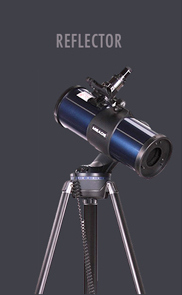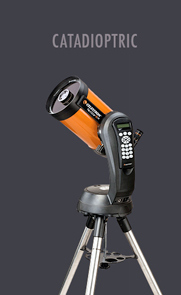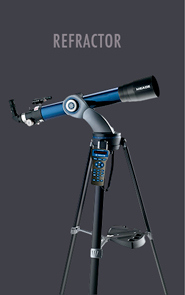Telescopes
Click on a State below to reveal a list of Observatories in that State, most of which are open to the general public. Next, click on the Observatory you are interested in and visit their official website.
Here you can find contact information, hours of operation, ticket prices, directions, etc. Many sites allow you to make reservations and/or purchase tickets online in advance of your visit. Tip: The Planetarium location (City, College, or Neighborhood) is shown in parenthesis.
Most Observatories are owned and run by major Universities.
Please review their terms and conditions before your visit. Many Observatories require a reservation and may request a small monetary donation to cover their cost.
Stargate Observatory (Wasilla)
Kitt Peak National Observatory (Kitt Peak)
Lowell Observatory (Flagstaff)
MMT Observatory (Mt. Hopkins)
Mount Lemmon Observatory (Mt. Lemmon)
National Optical Astronomy Observatory (Tucson)
Patterson Observatory (Sierra Vista)
Prescott Observatory (Prescott)
Chabot Observatory & Science Center (Oakland)
Foothill College Observatory (Los Altos)
Griffith Observatory (Los Angeles)
Hale Telescope (Palomar Mountain)
Lick Observatory (Mount Hamilton)
Mount Wilson Observatory (Mount Wilson)
Orange County Astronomers Observatory (Anza)
Robert Ferguson Observatory (Kenwood)
Taylor Observatory (Kelseyville)
Chamberlin Observatory (Denver)
Pikes Peak Observatory (Colorado Springs)
Sommers-Bausch Observatory (Boulder)
Bowman Observatory (Greenwich)
Leitner Family Observatory (New Haven)
Olin Observatory (New London)
Van Vleck Observatory (Middletown)
WCSU Midtown Observatory (Danbury)
Mt. Cuba Astronomical Observatory (Greenville)
EFSC Observatory (Cocoa)
Fox Observatory (Sunrise)
James & Barbara Moore Observatory (Punta Gorda)
Robinson Observatory (Orlando)
Rosemary Hill Observatory (Bronson)
UF Observatory (Gainesville)
Bradley Observatory (Decatur)
Hard Labor Creek Observatory (Rutledge)
North Georgia Astronomical Observatory (Dahlonega)
Ralph Buice Observatory (Atlanta)
Univ of Georgia Observatory (Athens)
WestRock Observatory (Columbus)
Gemini North Observatory (Mauna Kea)
K.E.A.S.A. (Manoa, Kauai)
Subaru Observatory (Mauna Kea)
W. M. Keck Observatory (Mauna Kea)
Goethe Link Observatory (Martinsville)
Holcomb Observatory (Indianapolis)
John C. Hook Memorial Observatory (Terre Haute)
Kirkwood Observatory (Bloomington)
McKim Observatory (Greencastle)
Prairie Grass Observatory (Frankfort)
South Harrison Observatory (Elizabeth)
Ashton Observatory (near Baxter)
Grant O. Gale Observatory (Grinnell)
John Witte Observatory (Sperry)
Menke Observatory (Dixon)
Banner Creek Observatory (Holton)
Clyde W. Tombaugh Observatory (Lawrence)
Crane Observatory (Topeka)
Farpoint Observatory (Eskridge)
Kansas Wesleyan Observatory (Salina)
Lake Afton Public Observatory (Wichita)
Powell Observatory (Louisburg)
Otter Creek Observatory (Brandenburg)
Highland Road Park Observatory (Baton Rouge)
LIGO Livingston Observatory (Livingston)
Worley Observatory (Shreveport)
Maynard F. Jordan Observatory (Orono)
Starfield Observatory (Kennebunk)
Stephens Observatory (Lewiston)
Maryland Science Center Observatory (Baltimore)
Maryland Space Grant Observatory (Baltimore)
Univ. of Maryland Observatory (College Park)
Ayer Observatory (Milton)
Hopkins Observatory (Williamstown)
John Payson Williston Observatory (South Hadley)
Judson B. Coit Memorial Observatory (Boston)
Vestal Street Observatory (Nantucket)
Wallace Astrophysical Observatory (Westford)
Wheaton College Observatory (Norton)
Whitin Observatory (Wellesley)
Angell Hall Observatory (Ann Arbor)
Brooks Astronomical Observatory (Mt. Pleasant)
Calvin College Observatory (Grand Rapids)
Detroit Observatory (Ann Arbor)
Fox Park Public Observatory (Potterville)
Hector J. Robinson Observatory (Lincoln Park)
James C. Veen Observatory (Lowell)
Joseph H. Rogers Observatory (Traverse City)
MSU Observatory (East Lansing)
Sherzer Observatory (Ypsilanti)
Cherry Grove Observatory (Kenyon)
Goodsell Observatory (Northfield)
Joseph J. Casby Observatory (Afton)
Macalester College Observatory (St. Paul)
O’Brien Observatory (Marine on St. Croix)
Onan Observatory (Norwood-Young America)
Paul P. Feder Observatory (Moorhead)
Sola Fide Observatory (Austin)
Kennon Observatory (Oxford)
Rainwater Observatory (French Camp)
Baker Observatory (Fair Grove)
Crow Observatory (St. Louis)
Laws Observatory (Columbia)
Morrison Observatory (Fayette)
Blue Mountain Observatory (Blue Mountain)
Behlen Observatory (Yutan)
Boswell Observatory (Crete)
Branched Oak Observatory (Raymond)
Honey Creek Observatory (O’Neill)
Hyde Memorial Observatory (Lincoln)
Sachtleben Observatory (Hastings)
Jack C. Davis Observatory (Carson City)
Harold E. Taylor Observatory (Galloway)
Peyton Observatory (Princeton)
Robert A. Schommer Observatory (Rutgers)
William Miller Sperry Observatory (Cranford)
Apache Point Observatory (Sunspot)
Dunn Solar Telescope (Sunspot)
Jansky Very Large Array (Plains of San Agustin Near Socorro)
Magdalena Ridge Observatory (South Baldy Mountain)
Univ. of NM Observatory (Albuquerque)
Beaver Meadow Observatory (Java)
Custer Observatory (Southold)
Darling Hill Observatory (Tully)
Ford Observatory (Ithaca)
Fuertes Observatory (Ithaca)
Hirsch Observatory (Troy)
Kopernik Observatory (Vestal)
Martz-Kohl Observatory (Frewsburg)
Mees Observatory (Naples)
SCCC Corning Observatory (Corning)
Stull Observatory (Alfred)
SUNY Oneonta College Observatory (Oneonta)
Vassar College (Poughkeepsie)
Dark Sky Observatory (Purlear)
Lucile Miller Observatory (Maiden)
Squirrel Valley Observatory (Columbus)
Three College Observatory (Graham)
Williams Observatory (Boiling Springs)
Willis Observatory (Bakersville)
MSU Observatory (Minot)
Space Studies Observatory (Emerado, near Grand Forks)
Apollo Observatory (Dayton)
Ballreich Observatory (Tiffin)
Brooks Observatory (Toledo)
Burrell Memorial Observatory (Berea)
Cincinnati Observatory (Cincinnati)
Perkins Observatory (Delaware)
Warren Rupp Observatory (Bellville, just outside Mansfield)
Weitkamp Observatory (Westerville)
Wilderness Center Observatory (Wilmot)
ACT Observatory (Mounds)
Mendenhall Observatory (Stillwater)
University of Oklahoma Observatory (Norman)
Allegheny Observatory (Pittsburgh)
Bradstreet Observatory (St. Davids)
Bucknell Observatory (Lewisburg)
Mehalso Observatory (Erie)
Naylor Observatory (Lewisberry)
Paul E. Hickes Observatory (Huntington)
Thomas G. Cupillari Observatory (Fleetville, near La Plume)
Univ. of Pennsylvania Observatory (Philadelphia)
Villanova Observatory (Villanova)
Widener University Observatory (Chester)
Frosty Drew Observatory (Charlestown)
Ladd Observatory (Providence)
Margaret M. Jacoby Observatory (Warwick)
Seagrave Memorial Observatory (North Scituate)
Charles E. Daniel Observatory (Greenville)
FMU Observatory (Florence)
Melton Memorial Observatory (Columbia)
Clarence Jones Observatory (Chattanooga)
Cordell-Lorenz Observatory (Sewanee)
MTSU Observatory (Murfreesboro)
Tamke-Allan Observatory (Rockwood)
Vanderbilt Dyer Observatory (Brentwood)
Eagle Eye Observatory (Burnet)
George Observatory (Needville, SW of Houston)
McDonald Observatory (Fort Davis)
Rafes Urban Astronomy Center Observatories (Denton)
SFA Observatory (eleven miles north of Nacogdoches)
Texas A&M Observatory (College Station)
South Physics Observatory (Salt Lake City)
Stansbury Park Observatory (Tooele)
West Mountain Observatory (Payson)
Fan Mountain Observatory (Albemarle County, about 15 miles south of Charlottesville)
Keeble Observatory (Ashland)
Leander McCormick Observatory (Charlottesville)
Stokesville Observatory (Stokesville, near Mount Solon)
Winfree Observatory (Lynchburg)
Goldendale Observatory (Goldendale)
Herold Observatory (Onalaska)
Jewett Observatory (Pullman)
Manastash Ridge Observatory (Ellensburg)
Pacific Northwest Regional Observatory (Wallula, west of Walla Walla)
Ritchie Observatory (Brainbridge Island)
Theodor Jacobsen Observatory (Seattle)
Good Hope Observatory (Clarksburg)
Morgan County Observatory (Berkeley Springs)
Tomchin Observatory (Morgantown)
Hobbs Observatory (Fall Creek)
Modine-Benstead Observatory (Union Grove)
Pine Bluff Observatory (Cross Plains)
Washburn Observatory (Madison)
Whitewater Observatory (Whitewater)
Yerkes Observatory (Williams Bay)
Red Buttes Observatory (Laramie)
A personal telescope is a fantastic way to introduce your child and yourself to the wonders of our universe.
There are a variety of products to chose from and some models function better than others, so it pays to do a little research before you make your purchase.
Below you’ll find information on some of the things to look for when purchasing a home-size telescope.
Telescopes
Thinking of buying a telescope?
Compare Telescope Styles.

Reflecting

Catadioptric

Refracting
Review the Pros and Cons of the Three Most Popular Personal-Style Telescopes
Telescope Pros and Cons
A reflecting telescope (also called a reflector) is a telescope that uses a single or a combination of curved mirrors that reflect light and form an image. The reflecting telescope was invented in the 17th century by Isaac Newton as an alternative to the refracting telescope which, at that time, was a design that suffered from severe chromatic aberration. Although reflecting telescopes produce other types of optical aberrations, it is a design that allows for very large diameter objectives. Almost all of the major telescopes used in astronomy research are reflectors. Reflecting telescopes come in many design variations and may employ extra optical elements to improve image quality or place the image in a mechanically advantageous position.
- Affordable
- The mirrors in reflecting telescopes are easier to make in larger sizes, resulting in larger apertures for the money
- Shorter tube, making them ideal for travel
- No chromatic aberration
- Many variants are available
- High maintenance
- The mirrors need to be collimated often. The process is pretty straightforward, so you can do it yourself
- Although not expensive, the mirrors need to be professionally cleaned and recoated once in a while

Catadioptric telescopes (also known as compound telescopes) mix some of the features from reflecting and refractor telescopes and are optical telescopes that combine specifically shaped mirrors and lenses to form an image. This is usually done so that the telescope can have an overall greater degree of error correction than their all-lens or all-mirror counterparts, with a consequently wider aberration-free field of view. Their designs can have simple all-spherical surfaces and can take advantage of a folded optical path that reduces the mass of the telescope, making them easier to manufacture. Many types employ “correctors”, a lens or curved mirror in a combined image-forming optical system so that the reflective or refractive element can correct the aberrations produced by its counterpart.
- Compact in size, catadioptric telescopes tend to be light and easy to carry
- Great optics
- Catadioptric telescopes are designed to minimize the optical errors from the other designs
- Less affordable than refractors and reflectors
- In general, they tend to be on the expensive side of the price spectrum for similar apertures.
- High maintenance. The mirrors need to be collimated, although not as often as in reflectors.

A refracting telescope (also called a refractor) is a type of optical telescope that uses a lens as its objective to form an image (also referred to a dioptric telescope). The refracting telescope design was originally used in spy glasses and astronomical telescopes but is also used for long-focus camera lenses. Although large refracting telescopes were very popular in the second half of the 19th century, for most research purposes, the refracting telescope has been superseded by the reflecting telescope, which allows larger apertures. A refractors magnification is calculated by dividing the focal length of the objective lens by that of the eyepiece. Refracting telescopes typically have a lens at the front, then a long tube, then an eyepiece or instrumentation at the rear, where the telescope view comes to focus.
- Affordable at smaller lens sizes, comparable to reflectors
- Lower eyepiece location allows viewers to sit in a chair instead of standing for long periods of time
- Sturdier, increasing their life expectancy if moved a lot
- They don’t need to be collimated
- Easier to use for smaller kids due to eyepiece location
- Subject to chromatic aberration if not corrected
- Apochromatic refractors solve most of this problem, but they tend to be way more expensive
- Can be unwieldy, refracting telescopes tend to be longer and heavier
- Their price increases significantly with the size of the lens vs that of a reflector

Popular Websites
Informative websites concerning NASA, The Solar System, Large Telescopes, and various Night Sky Objects.
More Popular Websites
Informative websites you might find interesting.